You’ve probably passed 225 Lafayette Street at the corner of Spring Street in Soho a zillion times in your travels and not thought much of it. Built in 1909, it was converted to condos in 1988; a typical unit now goes for over $1.5 million. The ground floor space, formerly the East River Savings Bank, has housed a number of upscale retail stores in recent years.
Thing is, 225 Lafayette indirectly played a very important role in my childhood, along with the childhoods of millions of kids across the globe. Quite possibly, it even had an effect on you. Because before it became overpriced condos, 225 Lafayette Street was a typical Manhattan office building with one very atypical tenant.
Located on the 7th Floor was a small comic book company known as E.C., or Entertaining Comics, who you might recall for one publication in particular:
The first issue of Mad I ever bought was issue #310 in April, 1992, at the ripe age of 10. And I gotta admit, though I loved it at first sight, I didn’t entirely understand it. Sure, I could laugh at the simpler (though brilliant) stuff like Spy vs. Spy, Sergio Aragones’ A Mad Look At…, Duck Edwing and Don Martin one pagers, and the fold-in…but a lot of it presented a view of the world that, lacking any real-world experience, really made me wonder: is this what life is really like??
I’ve mentioned before that I was first introduced to New York City as a kid after first seeing Ghostbusters, but I really came to be enchanted by it through the pages of Mad, in which it was depicted as a place of extremes. The subway was a place to get killed. Times Square was a primal circus, while Fifth Ave was full of elitist ultra-rich snobs. Greenwich Village was home to wackos, hippies, and wannabe bohemians, while a jog in Central Park was less a workout and more a way of escaping the mugger chasing you. A personal favorite that could still be played today (click for larger size):
On the one hand, I couldn’t imagine why anyone would choose to live in such a crazy place. On the other, I was fascinated by it. Growing up in Massachusetts, the biggest city I knew was Boston, and it was nothing like what I imagined New York to be.
In 1934, the very first comic book was created by a New Yorker named Max Gaines. Gaines, a salesman, had been cleaning out some old newspapers in his basement when he found himself reading some old funny pages…and laughing.
Thinking kids might enjoy them too, he put together a magazine of old strips called Famous Funnies, which was distributed through Woolworths. The dimensions, essentially mirrored to this day by comics, were simply the standard tabloid format folded in half.
It wasn’t long before an entire industry exploded out of Max’s creation; in fact, just four years later, the first issue of Action Comics featuring a new character named Superman was published in 1938.
Max Gaines had a son named William, or Bill to friends. Bill was a constant prankster, and regularly found himself in trouble. Max considered his son worthless, and as he entered his 20’s, Bill was starting to think his dad might be right. He was on track to become a high school chemistry teacher, taking courses at Brooklyn Polytechnic (now part of NYU), when tragedy struck: his father had been killed in a boating accident, and he was now the heir to a struggling comic book company known as Educational Comics.
This is Bill seated at the 7th Floor of 225 Lafayette Street, and his expression might give you a sense of how happy he was to take over EC, which was going through difficult times with mainly Bible and historical comics to their name (not very popular with the kids). Terrified at messing up what his father had built, Bill spent his first few months essentially signing checks and playing card games with friends. However, the sign on the wall offers a sense of what was to come: “Everything I like is illegal, immoral, or fattening.”
Based on the window lay-out, his office was almost definitely located in the corner space:
Faced with impending bankruptcy, Bill finally made the decision to try and compete in the world of comics. His first step was to change his company’s name from Educational Comics to the more appealing Entertaining Comics, and following that, began publishing knock-offs of what was popular in the early 1950’s: westerns, crime, and romance.
Bill met an artist named Al Feldstein, and a friendship quickly formed. Bill and Al were soon writing and editing numerous comics together, but barely making a dent in the market – there was just too much competition. Here, Al and Bill relax at an EC Christmas party at 225 Lafayette:
Then, inspiration struck: Bill and Al discovered they shared a love of horror and sci-fi radio dramas of the 1930’s and 40’s. Thinking kids might like to read a comic with scary stories, they published the first issue of “The Crypt of Terror”…
…which they would soon retitle:
Tales from the Crypt changed the industry. Sales skyrocketed, and Gaines and Feldstein continued to put out more and more horror comics, adding sci-fi, crime, and war titles to the mix. The artwork was beyond anything found in the pages of rival publishers, and the stories were top notch. There’s a reason why recent hardcover reprints include forwards written by Steven Spielberg, George Lucas, and John Carpenter, among others. And all of it came out of 225 Lafayette.
Pictured above is a man named Harvey Kurtzman. Kurtzman worked as a writer and artist at E.C., and was the creator/editor of E.C.’s revolutionary line of war comics. One day, Kurtzman came to Gaines and Feldstein with financial problems – he was hoping for an increase in salary, and would it be possible to add another title to his editing line? Musing about possible genre ideas, it was finally decided he would do a satire comic called Mad. The first issue hit the stands in 1952, the cover parodying their own line of horror comics.
Kurtzman wrote the comic single-handedly through the 1950’s, by which point it had transitioned into a “slick” magazine to avoid the censorship that had destroyed nearly every other E.C. title. When Kurtzman left for Playboy after demanding 51% ownership of the magazine, Feldstein took over as editor.
Under his watch, Mad’s readership quadrupled in size, and the magazine thrived throughout the 1960’s and ’70’s. Kurtzman often gets all the credit for inventing Mad, but Feldstein played an equally important in the magazine’s evolution, and is probably responsible for 98% of the issues you grew up on.
My first trip to New York was because of Mad Magazine. Sotheby’s was having an auction of Mad artwork, and my parents took me down for my 13th birthday in October, 1995 to visit. I’ll never forget driving down Broadway for the very time, passing the Letterman studio and seeing Times Square.
We went to Sotheby’s, and I was amazed to see all the original artwork up close. Bill Gaines had died 3 years prior in 1992, and one of the items being auctioned off was his desk. I remember looking closely at the desktop and seeing his scribblings still visible on the surface.
Then, a Sotheby’s employee came over, quietly opened one of the drawers, and took out an envelope with the Mad letterhead on it. He hid it in my program guide, then winked and walked off. Another moment I’ll never forget.
After the auction, my parents and I visited the Mad Magazine offices at 1700 Broadway, also the home to DC comics (their parent company). I was given a tour of the offices, met Bill’s widow Annie (then a managing editor), was given a packet of Mad freebies, and even met artist George Woodbridge, who was there to drop off artwork.
Of course, we couldn’t escape without a distinctly Mad prank. We asked for a recommendation for a good, reasonably priced place to eat, and were given an address. When we arrived, we found a fancy five-star eatery that required a coat and tie to be seated. Nice.
After that visit, my view of New York City completely changed. Yeah, it was the crazy, loud, fast-paced zoo I had expected – but in a good way, in an exciting way, in a way I had never felt anywhere else.
Sadly, Mad’s impact has diminished in passing years, and is now only published quarterly. However, that in no way detracts from the tremendous influence Mad, E.C. Comics, William M. Gaines, Al Feldstein, and Harvey Kurtzman have had on untold numbers of readers, many of whom went on to become the world’s leading filmmakers, writers, comedians, and artists.
Though E.C. has had several homes in New York over the years (350 3rd Ave, 485 MADison Ave, 1700 Broadway), the 7th Floor of 225 Lafayette Street is where it all started.
I’m sure Bill Gaines would’ve hated it, but can we please get a fershlugginer placque??
-SCOUT
PS – Check out Mad Magazine #318 and you’ll see a picture of a very young Scout in his Alfred E. Neuman Halloween costume.
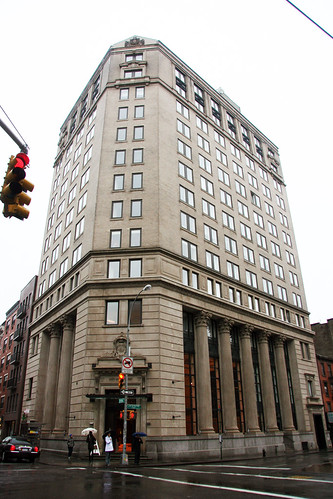
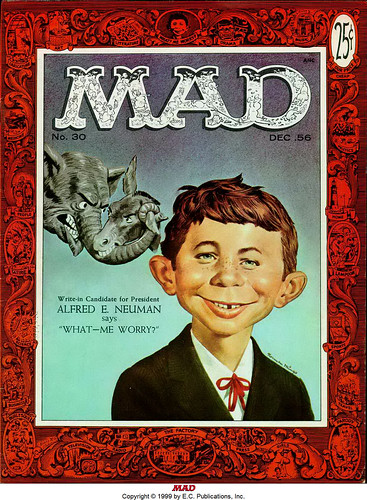

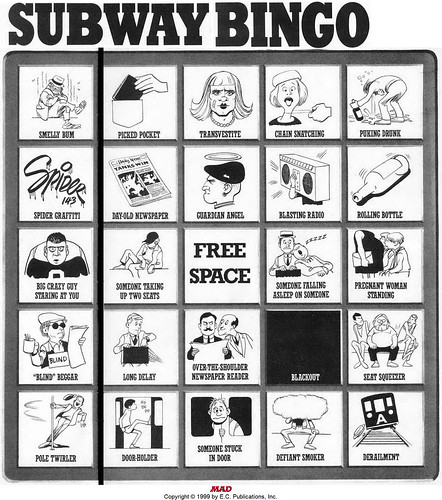
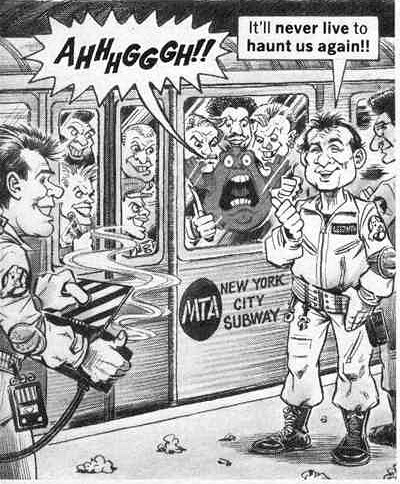


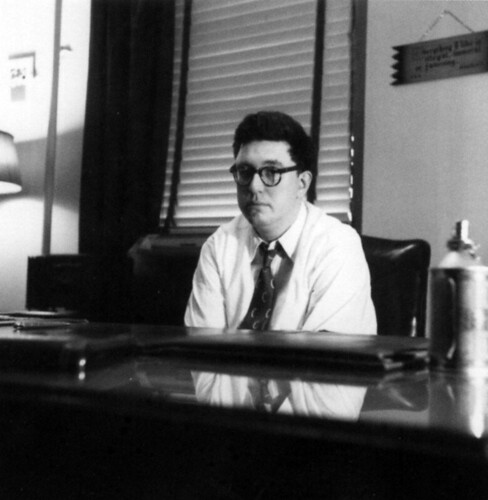

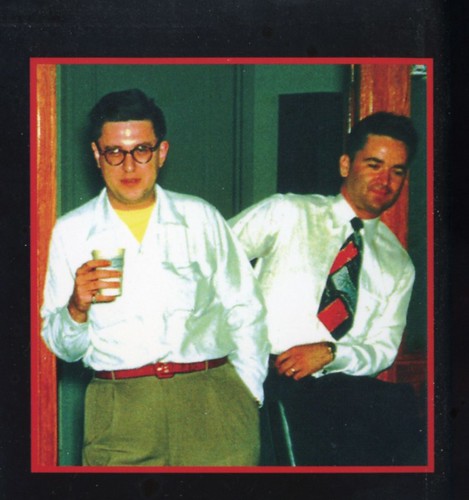

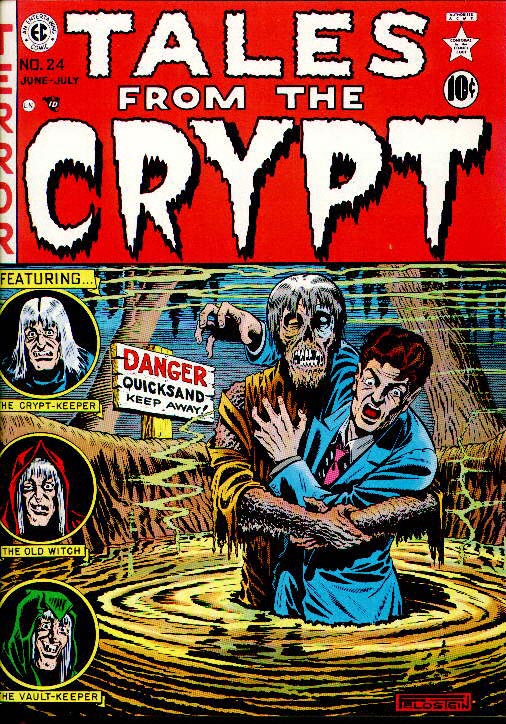


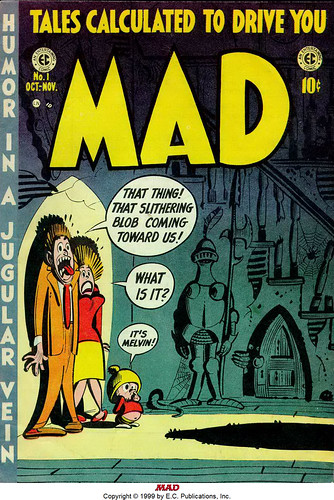
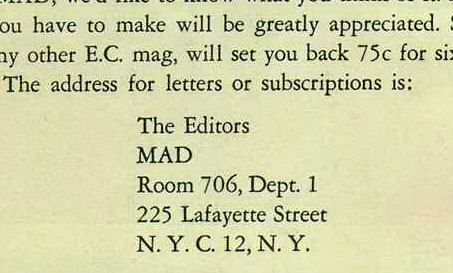
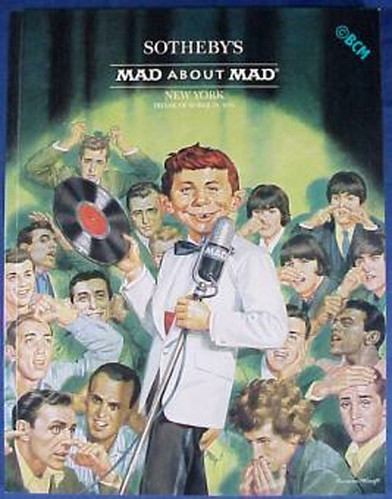


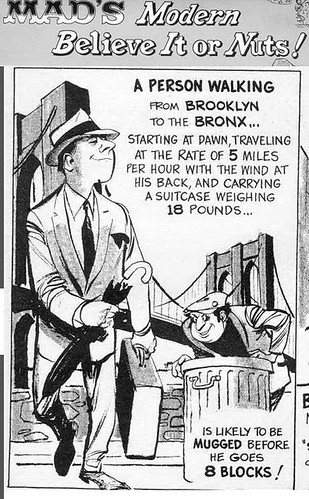
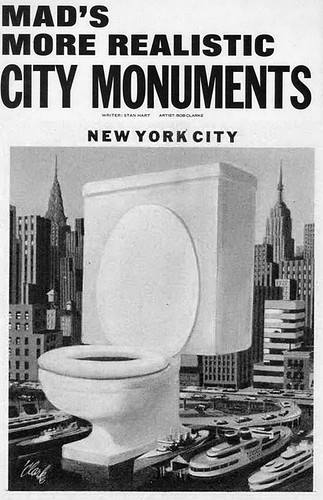



I grew up on a steady diet of Mad in the 60s and 70s. Its probably responsible for my skewed, somewhat cynical world view. I remember many of those bits about NYC. It wasn’t until my first visit in 2000 that I realized what a wonderful place it was. How perfect that my favorite magazine from childhood was there!
Im surprised there is no mention of Don Martin in your article. He was certainly responsible for my sick sense of humor, later leading to the likes of Gary Larson, Doonesbury; I cherish the two volume collection my husband bought for me one birthday. Thanks for your history, lovely to revisit that time.
I’m a good 25 years older than you, Scout, but MAD had a similar influence on me. I was growing up in Michigan in the 1960s and learning about NYC from MAD and the movies. When we moved east in 1969 (when *I* was 10), I also got to see how my imagined NYC compared to the real thing.
I’ve written a little about MAD’s role in my life in a couple of my own columns on comics in academia:
http://www.comixology.com/articles/335/May-the-Schwartz-Be-With-You
http://www.comixology.com/articles/128/The-Child-is-Father-to-the-Man-er-Mother-To-the-Woman-Whatever-
Thanks for sharing the Lafayette St history! I’ve been to the offices they share with DC Comics, but never their earlier incarnations.
Hey scout-
Beautiful sight!
Can you recommend how to break into film/tv scouting?
My background is still photo production, I am a natural, obssessive scout.
Is there union that includes scouts?
many thanks! Hill
And another kid here whose childhood and worldview are eternally warped by reading Mad from an early age. I became a fan of the EC Comics later on, but it took me a while to put 1 and 1 together, that they were related to Mad. The whole story of EC’s breakdown and the rise of Mad is truly fascinating and inspiring. When I arrived in NYC 5 years ago, checking out the Lafayette building was one of the first things I did. Older Mad magazines carry fake advertisements, with the Mad staff as models. Some of these were shot in front of the building, which you can recognize in the background.
Pingback: Monday Morning LinkBlogging » Comics Worth Reading
Nice one scout! If you havent read it, check out David Hajdu’s
“The Ten-Cent Plague: The Great Comic-Book Scare and How It Changed America” – some good history on Mad/EC in there.
Pingback: Nabe News: May 3 - Bowery Boogie | A Lower East Side Chronicle
nice work scout .. spent my youth at the cottage reading MAD on rainy days .. nice article .. you should try to get this one published.
When I was a student at nearby Stuyvesant High School in the late 1950’s, I often went to EC’s office on Lafayette Street to get the very latest issues, so I got to meet Feldstein and some of the others, including Marie Severin, John Severin’s sister, who colored the stories. One work table with a shorter leg was stabilized with a pile of Mads. They were always kind to this pesky kid who bothered them. Who knew that one day my son-in-law would become an editor at Mad. I also occasionally went down the hall to pester Paul Krassner, who edited a very personal anarchic magazine called The Realist. If you don’t know this, check out the archives at http://www.ep.tc/realist/. It was quite a building.
I’d forgotten the address for the Realist (where I worked as Paul Krassner’s “scapegoat,” a title I’d invented) until I was reading today about Alger Hiss… and came across this: “After his release in 1954, Hiss, who had been disbarred, worked as a salesman for the stationery company S. Novick & Sons located in the Puck Building, 225 Lafayette St. in New York City.”
What a building.
Sorry to correct you, Ms Baldwin, but the address of the Puck building is 295 Lafayette (at Houston Street), where, as it happens, my daughter and Mad-editor son-in-law had their wedding.
Just goes to show how the internet can muddy the waters of historical accuracy! I was just quoting another post, and now I see that the misinformation is rife. This must drive you nuts, having a personal stake in the building (as I seem to in the address).
Hearing ole 225 Lafayette called “the Puck Building” was news to me, so I’m glad to be set straight. Or straighter.
225 Lafayette is NOT the Puck Building. That one is at nearby 295 Lafayette, on Houston Street, and became known as the Puck Building when Puck Magazine was published there from 1887-1918. Spy Magazine also had its offices there in the 1980s.
wow- what a great rush of memories! i remember being scared witless by my brother’s collection of ‘Tales from the Crypt’ and MAD magazine-well, it likely shaped the sardonic sense of humor of many of us. The best parodies ever, and funny misguided advice. I remember one hint MAD gave- cut the bottom out of the base of a garbage can and carry the can around in the car. Then when you need a parking space, just slip the can over a fire hydrant, where no one parks, and you have an instant space. I’ve never done it, but boy, have I thought about it! Thanks for the trip back. (love your blog!)
Scout,
Fantastic article. One recent positive change is that Mad has announced a bi-monthly run.
Doug
Hey-this was cool reading! Thanks!!
Pingback: A MAD Address | Tom's MAD Blog!
I started reading MAD in the mid-70’s, just when I began to become politically aware, and it greatly influenced my thinking and my lack of reverence for authority. It also fed my lifelong hunger to be a New Yorker (I was born in Milwaukee but longed to live in a real city. Not that I don’t love my hometown). I always got a kick out of their portrayal of dog poo and expected to see mounds of “sausage links” on the sidewalks of New York. Sadly, I have not been disappointed on that score.
Pingback: Duane Reade Opening at 225 Lafayette on July 31 - Bowery Boogie | A Lower East Side Chronicle
Nice article about E.C. Comics’/MAD’s first offices… Just an FYI: 225 Lafayette Street was also the publishing offices of All-American Comics, Inc. and the birthplace of The Flash, Hawkman, Green Lantern, Wonder Woman and other comic characters that M.C. Gaines published from the late 1930s to mid 1940s before starting up E.C. Comics in 1945.
Pingback: The House That Created Howard Stern « Scouting NY
Brilliant. Again. Please close this site down before I get fired. You are doing such a fantastic job, I’m not even jealous of you anymore, I just want to retire so I can spend more time with you (metaphorically speaking, of course).
Small bit of “factual” info in this article, The building was converted to co-ops after 2003, not 1988 as stated above. I had an internet development company that started in one small corner office 701, in 1996, eventually we took over most of the 7th floor for Interocity development Company. I was one of the owners and I had the privilage of having Harvey Kurtzman’s old spot for my own office, just behind the corner windows on the 7th floor. Having been a life-long comics enthusiast it ment a lot to me to sit in that spot. We originally choose the building because it was still “old New York”, in those days you could walk down lafayette St. from Houston and the skyline still looked like 1940’s, the building had hallways lined with “Sam Spade” wooden doors with frosted glass windows. I vacated in 2001, a very memorable space. It was at least two years later before it wound down as an office building.
Fun fact: after MAD moved out, Roadrunner Records (Slipknot, Nickelback, Type O Negative, etc.) moved in.
http://www.roadrunnerrecords.com/news/history-in-brief
Well, about a quarter century after MAD moved out… MAD left the building in the early 1960s.
Have loved MAD since the early 70s when I was a kid. I always liked the one page collage of hundreds of characters put together such as a scene at a fair or carnival. I could return a week later and see something new. In fact, I could return a year later to review the collage and see something new.
Did anyone notice that “IND” within the mag’s title MAD? I always thought the real title was “MAD MIND” but for some reason the mag creator’s kept the IND small.
Many people thought that. The real answer is much, much duller: newsstand copies of MAD were shipped by a company called Independent News Distribution. IND stood for INDependent.